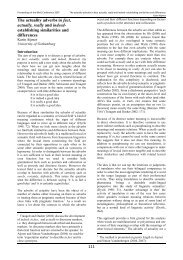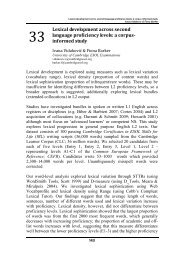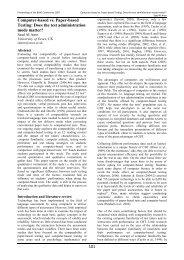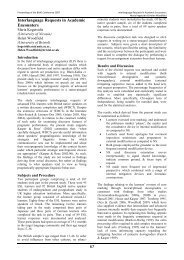Proceedings of the - British Association for Applied Linguistics
Proceedings of the - British Association for Applied Linguistics
Proceedings of the - British Association for Applied Linguistics
You also want an ePaper? Increase the reach of your titles
YUMPU automatically turns print PDFs into web optimized ePapers that Google loves.
The Impact <strong>of</strong> <strong>Applied</strong> <strong>Linguistics</strong>: <strong>Proceedings</strong> <strong>of</strong> <strong>the</strong> 44th Annual Meeting <strong>of</strong> BAAL<br />
University <strong>of</strong> <strong>the</strong> West <strong>of</strong> England<br />
Discussion<br />
The pilot data show clear cross-linguistic differences between German,<br />
Korean and Spanish learners, reflecting rhythmic characteristics <strong>of</strong> <strong>the</strong>ir<br />
native languages. In terms <strong>of</strong> consonantal material in <strong>the</strong> speech stream, <strong>the</strong><br />
German learners were – as expected – closest to <strong>the</strong> English target but <strong>the</strong>ir<br />
Varco-C is still not quite high enough. Having a stress-timed language<br />
background, German learners naturally have more consonant clusters in<br />
<strong>the</strong>ir speech already and are familiar with vowel reduction, even though<br />
this happens to a lesser extent in German. The amount <strong>of</strong> vocalic material<br />
increases in German learners from B1 to B2 level. However, while <strong>the</strong><br />
initial development is in <strong>the</strong> direction <strong>of</strong> native <strong>British</strong> English values, <strong>the</strong>ir<br />
speech is more vocalic than that <strong>of</strong> L1 English speakers at B2. A possible<br />
explanation is that B2 German learners <strong>of</strong> English over-generalise newly<br />
acquired rules. When learners understand that accented syllables, <strong>for</strong><br />
instance, have a longer duration and thus a higher percentage <strong>of</strong> vocalic<br />
material, <strong>the</strong>y might exaggerate accentual leng<strong>the</strong>ning, or <strong>the</strong>y might apply<br />
it in syllables which would normally be reduced.<br />
Korean and Spanish learners, who have mostly CV structures in <strong>the</strong>ir<br />
native language, have a relatively low number <strong>of</strong> consonants in <strong>the</strong>ir speech<br />
as reflected by a low Varco-C value. This shows that in consonant clusters<br />
<strong>the</strong>y still delete some consonants or insert vowels to break a succession <strong>of</strong><br />
consonants. While Korean learners do not show any difference between B1<br />
and B2, Spanish learners show a progression towards native-like values.<br />
The same holds true <strong>for</strong> vocalic material. With a ra<strong>the</strong>r high percentage <strong>of</strong><br />
vowels still at B1, <strong>the</strong> Spanish learners significantly reduce <strong>the</strong> vocalic<br />
proportion at B2 level, even slightly below <strong>the</strong> native English values. From<br />
this data we can conclude that our Spanish speakers are moving away from<br />
full transfer <strong>of</strong> prosodic properties, and that <strong>the</strong>y are starting to master L2<br />
properties such as complex syllable structures with clusters <strong>of</strong> consonants,<br />
and vowel reduction.<br />
Conclusion<br />
This pilot study shows that rhythm can be objectively measured to analyse<br />
L2 speech from learners’ with typologically different L1 backgrounds. In<br />
language learning we are concerned with both intelligibility and accuracy<br />
and should note when, how and why each is required <strong>for</strong> learners. These<br />
results can help us understand what learners <strong>of</strong> a specific L1 can do (in a<br />
20







